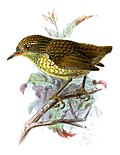Distribution and habitat
The bare-necked fruitcrow is primarily a bird of the Amazon Basin, although its range skirts much of the Negro River watershed in the northern part of it and also includes the basin of the Orinoco River. One arm of its range extends from far eastern Colombia and southwestern Venezuela across far northern Brazil and the Guianas to the Atlantic and south from there to join the rest of the range. The bulk of its range extends from south-central Colombia, eastern Ecuador, and eastern Peru east through northern Bolivia and north-central Brazil. In Brazil the main range's northern edge is roughly from west-central Amazonas east to Amapá and its southern edge from northern Mato Grosso do Sul northeast to the Atlantic in Maranhão. [10]
The bare-necked fruitcrow inhabits humid forest including várzea and terra firme types. It tends to be most frequent along rivers and around lakes. [10] [11] In elevation it is found below 500 m (1,600 ft) in Colombia, below 300 m (1,000 ft) in Ecuador, below 600 m (2,000 ft) in Peru, and below 150 m (500 ft) in Venezuela. [12] [13] [14] [15]
Behavior
Movement
The bare-necked fruitcrow is often seen in small flocks along and crossing rivers, but it is not known if this movement is local or represents seasonal migration. [10] [14]
Feeding
The bare-necked fruitcrow feeds mostly on fruit and also includes small and large insects in its diet. It forages singly, in pairs, and in flocks. Atypically among cotingas, it takes much fruit and insects while running or hopping along branches. It takes some insects, for instance flying ants, in mid-air with sallies from atop a tree. [10] [13] [14]
Breeding
The bare-necked fruitcrow's breeding season varies latitudinally, becoming later south to north. The one described nest was a shallow cup made from lichens and thin plant fibers coated with fungus. It was on a horizontal branch at an estimated height of 6 to 10 m (20 to 35 ft) above the ground. Another, not otherwise described, was 40 m (130 ft) up in the crown of a tree. The clutch is believed to be one egg. Nothing else is known about the species' breeding biology. [10]
 | Songs and calls
|
Vocalization
The bare-necked fruitcrow is described by some as silent [11] or "apparently mute" [13] . Nevertheless, its voice has been described as a "deep bellowing oooooooo like a fog-horn". [16] As of October 2025 xeno-canto and Cornell Lab's Macaulay Library each had a single recording. [17] [18]
This page is based on this
Wikipedia article Text is available under the
CC BY-SA 4.0 license; additional terms may apply.
Images, videos and audio are available under their respective licenses.





